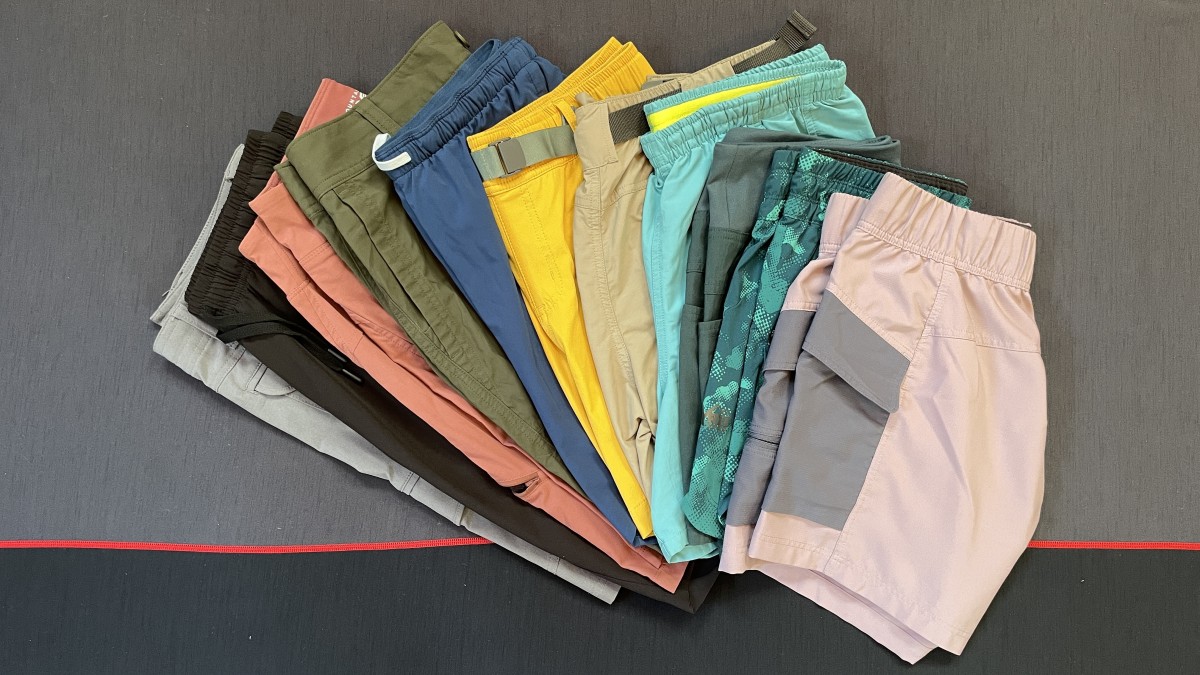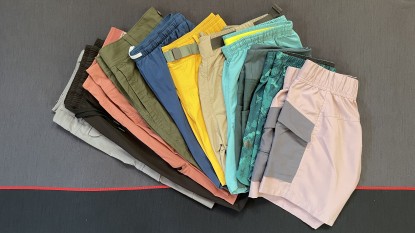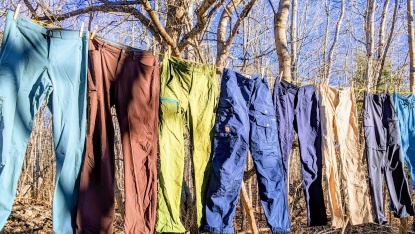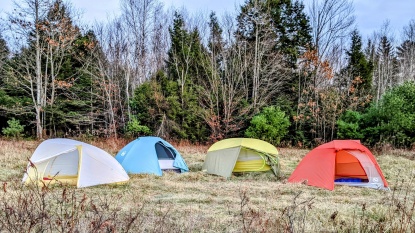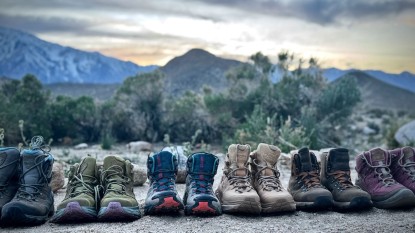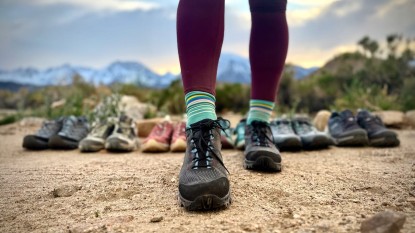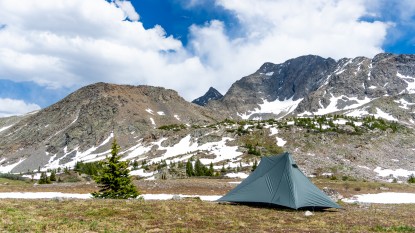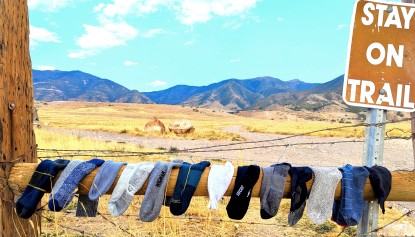Our goal is to make choosing a pair of the top women's hiking shorts easy. No matter where you live, we want you to feel ready for whatever hiking adventure you're planning. This category of apparel is typically designed with function as the top priority. Style does not necessarily take center stage, yet over the years, we have noticed brands taking the initiative to combine both function and style. The basic idea is for these kinds of shorts to perform with the body and not against it. Whether the temperatures are hot or cold, or whether the trail is flat or steep, the materials used should breathe well, feel comfortable, and be durable enough to withstand use in the outdoors. Style and fit preferences will differ from person to person, so we're thankful to provide various designs for you to consider. Your personal agenda will also dictate the necessity of features and advanced material technologies, such as water resistance, odor control, and sun protection. But these added perks are nice no matter what, so make sure to keep comfort, mobility, and versatility at the top of your list when thinking about which pair to buy. Since it can be challenging to differentiate between different types of shorts, like running or fashion apparel, we help break this category down by discussing distinct differences.
Hiking Shorts vs. Running and Fashion Shorts
While it's easy enough to find designs out there that encompass all three style types, what are the fundamentals that distinguish each of them? As modern trends ebb and flow, there are many instances where the lines become heavily blurred. Nonetheless, some aspects of each design style can be easily identified. To help define a pair made for hiking, the first distinction to consider is the intention behind the product and the language used to describe it.
Manufacturers usually have extensive descriptions and suggested uses. For apparel intended for outdoor use, brands may incorporate keywords such as “for varied conditions,” "outdoor adventure," or “technical trekking” into their product descriptions. The materials used will similarly be described using terms such as “durable,” "breathable," or “quick drying.” This will extend into a list of features and qualitative measurements deemed pertinent for outdoor use, such as sun protection (with a UPF rating), overall weight (ideally less than 10 ounces), or whether or not a fabric is “moisture-wicking” or “flexible.”
Why these keywords? As you can imagine, hiking requires repetitive movement through varying environments and conditions, and thus, manufacturers are going to sell you a pair of shorts they feel are adequate or exceptional in meeting these requirements. To accomplish the demand for high-tech or high-performance apparel, they often use synthetic materials, such as nylon, polyester, and sometimes cotton-based materials with added spandex or elastane. While fashion shorts may also be built with such materials, there isn't the same focus on thermoregulation as what is necessary when designing for outdoor activity. The focus on high-tech fabrics isn't just about comfort or looks when it comes to outdoor apparel; it is also about survival. Synthetic fabrics generally dry faster than cotton, meaning they not only help to reduce chafing and keep you dry while on the go, but they also have a higher likelihood of mitigating potentially hypothermic situations when inclement weather arises and/or when temperatures drop.
One of the other key difference between synthetic fibers and natural fibers, like that of cotton, is that synthetics are not derived from plants or animals and are often cheaper and more stain-resistant than their natural counterparts. However, as the sustainability movement progresses, brands are all the more encouraged to mitigate waste and utilize eco-friendly processes and materials. In recent months, many manufacturers, led by such eco-conscious brands as Patagonia, have moved toward the use of PFC-Free DWR (Durable Water Repellant) treatments, choosing to incorporate materials that are now free from “forever chemicals,” which are shown to be harmful to both the consumer and the environment.
Since hikers are generally going to be moving a lot in their clothing, it is very likely heart rates will go up, and sweating will occur. Synthetic apparel tends to be thinner, stretchy, and ideally constructed in a way that promotes airflow. Common benefits of nylon and polyester are natural mold resistance, baseline durability, and greater ease of cleaning. In conjunction with these performance-minded characteristics, athletic apparel should also have pockets, be they for your hands or to hold small essentials like a car key. Most hikers expect to be able to carry a phone these days, even on the trail. So, we are stoked to see that many brands are finally giving women's apparel deep pockets, too!
The final distinctions you are likely to see on hiking shorts versus other types come in the form of their inseam lengths and athletic styling. Hiking shorts are traditionally much longer than fashion and running shorts (although there arguably are many longer styles for fashion shorts as well), with a typical range falling somewhere between 5 and 10 inches. If we lean into stereotypes, the shorter the inseam, the more “youthful” the vibe, and the longer the inseam, the more mature and practical, even if there are by no means set rules. We love it to see brands and their audiences challenge these tropes. Many brands may offer classically elegant shorts with long inseams yet also produce equally simple, non-assuming shorts with shorter inseams. Options abound; as long as the comfort, mobility, and breathability are there, you'll be set.
Running Shorts
The act of running requires a lot of flexibility and space for the legs to move. Because of this, running shorts tend to be far more minimally designed and fundamentally ultralight. Many styles involve a dolphin, or split-short, design, which is wonderfully breezy but far more exposed. The split refers to a tapered and triangularly shaped cut (an exaggerated scallop) between the front and rear sections of the shorts, allowing for the utmost venting at the sides of the legs. In the most extreme cases, the height of this split can meet the waistband — producing significantly more exposure than many women prefer. For this reason, this style is also likely to incorporate an internal brief — like a pair of built-in underwear — to offer some degree of support and coverage. Another design for running shorts, which is becoming all the more popular, is a body-con spandex style that straddles the borderline with full-coverage underwear (think the bikini bottom styles female athletes wear at the Olympics). This is potentially the most aerodynamic shape and is often a standard among professional racers, but there is also a movement to allow the pros to choose whatever they want to race in. Lastly, there are in-between and casual designs that skip the scallop or dolphin cut but still come built of ultralight material simply cut in a loose and airy manner around the thigh.
Running shorts are also usually the shortest type around. Having an inseam of 5 inches or less is what we would consider standard for women's running shorts. With a similar use of synthetic materials as what is seen in hiking shorts, the biggest differences come down to features. What is useful for hikers may be a burden for runners, so design teams work to maximize the results for each group. Water resistance can diminish the breathability of the fabric, so it's seen less often in running shorts than in hiking options. Having too many pockets may diminish mobility or breathability as well. However, there are strategic ways to incorporate a pocket for runners, even one big enough for a phone, like a rear pocket with a zipper on the back of the waistband that holds the phone snugly to avoid bounce. The priority for running shorts is material that is not cumbersome (i.e., fabric that helps in maintaining speed and mobility) and is highly breathable. Depending on how much you run, a low-mileage jaunt, even when in the rain, won't be an issue in shorts that absorb water readily. Those that are built with ultralight synthetic materials are designed to dry very quickly. More often than not, if there is not a phone pocket, then the only added feature may be tiny stash pockets stitched into either the side of the hip and/or the inside of the waistband above a thigh. Lastly, internal drawstrings to cinch an elastic waistband and ensure proper fit are also standard, as there are no buttons, snaps, or zippers for closure.
Fashion Shorts
These are intended for casual to semi-formal outings only, with no expectations to perform for specific athletic endeavors or to manage changing weather or heavy sweat. In short, fashion shorts are exactly that: a warm-weather fashion statement. The vast array of materials and designs is incomprehensible, but the main and most important characteristic of their designs is aesthetic. Stitching can be thoughtful and creative. Materials are usually heavier and not meant to be very breathable, while pockets tend to be smaller and not always functional (though, perhaps this is changing, too). The use of zippers and button closures can be characteristic of those that pull from jean-inspired looks. While hiking shorts may also utilize a variety of similar types of waist closures, the goal of a streamlined and lightweight fit is not necessarily a priority for such fashion apparel.
The benefits of trendy options are, of course, subjective and bound to wherever you take your personal inspiration from. But it is safe to say nothing is stopping you from being a fashionista in the woods. From casual and functional styles to the avant-garde, there are endless choices. The aesthetic is primarily dictated by the type of fabric, including the colors and patterns available, plus any unique features in the cut or added as accessory components. Whether that choice is a casual knit, classic cotton, trendy treated denim, or includes some sort of extra special features like lace or clever stitching, the look attained by fashion shorts typically outweighs the need for long-term comfort and practicality. Fashion apparel can not only miss the mark when it comes to comfort and performance under active use, but it can also be misleading in the durability department — a pair of shorts that shreds easily is never going to be a great choice for days on the trail.
Key Hiking Essentials
When we brainstormed what metrics to test for, we knew that all of them would be performance-based. Long-term comfort, stretch, airiness, versatility, and construction quality are the recommended fundamentals of a great pair of hiking shorts. Keeping these characteristics in mind will help you determine the technical and bottom-line value of each pair you consider.
Over the years, we've tested a range of inseam lengths from super short to knee-length coverage. We feel the prime comfort zone for length to be between 5 and 10 inches. If the material is thin and flexible, inseam length doesn't particularly matter. If the material is on the thicker side, or if the cut of the design is slim (as opposed to a relaxed fit), then this is when inseam length can become a detriment to comfort and mobility.
Comfort and Mobility
Comfort and mobility can be a deal-breaker. When trying on a pair of shorts, if there are concerns about comfort right away, do not ignore them. Imagine an all-day adventure or the most challenging hike you can see yourself doing. Will the shorts keep you happily moving and chafe-free? The waistband should not dig into you, feel bulky, or feel too warm. Wider waistbands are usually better at distributing pressure, but make sure they aren't too thick. Otherwise, they are likely to trap heat and sweat. If you're going to carry a backpack with a waist belt, how would the waistband of the shorts feel beneath the backpack belt? Be sure to consider any buttons, belt loops, drawstrings, or clasps, and think about how they sit against your middle and how that fit might change once a pack is added over the top.
When examining fit, be sure to test your range of motion. Bringing your knees up toward the abdomen or performing a squat should be a fluid motion. The material should not dig into the thighs, butt, or hips. We understand this can be tricky to design for a broad potential audience since leg, hip, and waist ratios can differ for everyone. But, if you have to budge on flexibility, at least make sure you can sufficiently bring your knee toward your abdomen, ideally above a 90-degree angle, with relative ease. This will make all the difference on the trail when you start moving uphill, particularly if you're a hiker who loves steep and rocky terrain. If you're feeling spicy, try some yoga poses, crouch down, and scale a flight of stairs —- in essence, move around as much as possible to gauge how the shorts move with your body.
Do you carry your phone with you everywhere you go? I know we do — a hike didn't happen unless you have photos to prove it, right? But in all seriousness, when you try on a pair of shorts, put your phone in any and all pockets. Does the fabric stretch enough to allow you to high-step with the phone? Does your overall comfort in the pair change? Do the pockets even fit your phone at all? Consider how you are likely to want to carry your essentials with you on the trail, be it in a pocket or in a pack, and be sure you test each pair accordingly so you can select a pair of shorts that accommodates your needs.
From our experiences in field testing, we find that models with a relaxed fit, as opposed to a slim fit, are the most comfortable and accommodating to general movement. Unless you're going for a legging/full spandex design (which is super stretchy and flexible), hiking shorts are usually better off on the more open and flowy end of the spectrum. But no matter what length or cut you choose, the best shorts for you will be well-fitting, comfy, and easy to move around in, regardless of where you're going or what you're doing.
Fabric Performance
Nearly just as important as comfort, fabric performance is where we begin to focus more on the technical features of the shorts. Given they are intended for the warmer months of the year, the best hiking shorts are going to be breathable and well-ventilated to help mitigate excessive sweating and avoid discomfort. Looser leg openings will vent more easily than shorts with a slim and next-to-the-skin cut. A thinner, lightweight fabric can also contribute to greater airflow. However, it's worth noting that the models that breathe the best might not be as comfortable in very windy or very cold conditions (for that, you may prefer hiking pants).
Even with short inseams, material that is denser and stiffer, such as those primarily made of cotton, won't allow for optimal moisture-wicking and temperature regulation on muggy days. Perhaps ideal for when the sky is overcast (yet, who can predict that), we find thicker options generally only offer average results. While added length implies more insulation in general, knee-length styles can be open enough at the hemline to allow ample air circulation. We've seen an increase in mesh-lined pockets in recent years, which is another design tool that improves airflow and quick drying capabilities. Other ventilation features to keep an eye out for are perforated holes in the waistband or along the body and/or scalloped hems. A good trick to check for adequate breathability in the fabric itself is to see if you can blow air through it with your mouth or, vice versa, breathe air in. Another easy trick is to hold up the fabric to a light source. Fabric that generously allows air to pass through will typically have a more open weave, allowing light to pass through as well. If a pair has a DWR treatment and is highly water resistant, then breathability will likely be diminished, although not entirely.
Sun protection and other fabric technology features are far more ubiquitous in hiking apparel these days. But you never know. If the manufacturer mentions a UPF rating of 30 or above, this is a nice extra to have. It means that UV radiation created by the sun is diminished by the fabric down to a very small percentage, protecting the skin beneath the clothing that we may not have considered putting sunscreen on. Nearly all of the shorts we recently tested have a notable UPF rating. For any that do not, we have labeled them in our comparison chart so that you have a better understanding of which pairs offer such protection and how much. Other tech-fabric features that may be highlighted by brands include odor control, water resistance, and the use of recycled materials (always a plus if you are concerned about sustainability). Certifications like Fair Trade or Bluesign concern the manufacturing processes used to create the apparel, guaranteeing the item meets high environmental, economic, safety, and social standards (i.e., no sweatshops).
The last thing to consider for fabric performance is the “quick drying” nature of each short. Manufacturers love to use this phrase, but what does it actually mean? We performed a soak test to determine how well each pair dried after being saturated. Specifics of our testing can be found in our How we Tested article, but interpreting this data might be confusing to some. The word quick can mean something different to everyone. In the world of hiking apparel, it's important to note such language doesn't mean “instantaneous.” The fastest-drying competitor in our current review still took 22 minutes to air dry, and the slowest took basically an hour. In the context of the outdoors, this can mean a variety of things. If it's scorching hot out and you find a creek, soaking your apparel to cool down is a welcome reprieve. The faster the shorts dry, however, the more often you have to soak them to keep yourself cool. In these scenarios, a fabric with a slower drying time may be preferable. For example, runners who participate in the very gnarly Badwater 135 race often actually lean on cotton blends because such fabric holds onto water far longer than synthetic materials do. But let's face it: that's a very specialized scenario, and most hikers will seek something that helps keep them dry.
Among the many reasons we might prefer shorts with quick-dry characteristics is the likelihood of changeable weather. If, for some reason, you happen to get caught in a passing thunderstorm with a sudden drop in temperature or perhaps get lost on a trail as nighttime descends, your clothes will determine how well you maintain your core temperature, and those that dry quickly will do the best job of keeping your relatively warm. Beyond such survival scenarios, apparel that dries readily is also a nice feature to have when you return to your car after sweating on the trail all day or stopping to splash in a stream or lake on the way out. It's nice to know you won't have to worry about remaining wet for the drive home. In the end, there are many perks to having a lightweight, breathable, and quick-drying material for your hiking shorts, making it worth seeking out such options.
Versatility and Style
Here, we consider both the aesthetic style of each pair of shorts and also the potential for multi-sport uses. This metric is by far the most subjective and conditional, and while it doesn't bear quite as much weight as it has in previous iterations of our review, it's still an important consideration for most shoppers. On a practical level, having the option to hike across varied terrain during the summer is the most important consideration we tackle during testing. Yet for those with a fashion-oriented mindset or who seek athleticwear that can easily transition between a variety of activities and events, versatility and “good looks” are going to rank as considerations, too. Before you go shopping, it's best to think through the types of outings you will want your shorts to work for. Maybe you'd like to show up to lunch in the same outfit you just hiked in. Or, perhaps you want more technical design features for the flexibility to tackle a bit of bouldering or paddleboarding in addition to your trail time. Or maybe you want to jump on your bike to ride to and from the trailhead. Versatility is often a byproduct of comfort and mobility in our minds, but inseam length can also come into play, especially when hiking during shoulder seasons or in environments that are cold, wet, or heavy in vegetation that might scratch or scrape your legs on the trail.
This metric celebrates the cross-activity potential, multi-seasonal appeal, and modern styling options of hiking shorts today. More athletic designs may not be as desirable to wear around town but are often more useful across a broader range of outdoor activities. On the flip side, some shorts have a more town-ready or trendy fashion appeal to them due to their color, pattern, or specific cut. Thinking about everything you may ever want your shorts to do for you can be a little much, though, and we get that. So, in some cases, it may be best to purchase specific pairs for specific uses. But no matter what aesthetic you prefer, these days, there are more options than ever. You should have no problem picking up something that is both super cute and super functional for hiking.
Construction Quality
Although this metric carries the least weight in the overall score of each product tested, it is still an important consideration for all outdoor apparel. No one wants to waste money on clothing that won't stand up to the job at hand or find themselves having to replace an item after only a single season of use. The market for hiking apparel is broad, and the closer you look, the more you recognize the range of quality you will find. Many products truly won't stand up to the wear and tear of bushwhacking, scrambling, or the high-use demands of day hikes, backpacking, or thru-hiking. Such considerations warrant another look at each product through a different lens. Here, we consider the types of adventures one might plan and how well each short is built to make it a success.
Reading online reviews from other shoppers can be one helpful step in determining the long-term quality of any item and is likely one of the best ways to do so. But new-to-the-market options won't likely have any reviews yet, and we always want to be sure to do our own investigations into any item included in our lineups. To this end, not only did we conduct extensive field testing, we also ran a handful of “in lab” tests to gather a holistic understanding of their construction.
To start, we ran a snag test to mimic the kind of abrasive damage a pair of shorts might face on a particularly rugged, vegetation-heavy trail. By dragging an open paperclip along the material and stitching on each pair, we gather insights into the general durability of the material components themselves. Next, we took a look at the seams, a common weakness in all types of clothing. This test involved measuring and comparing the number of stitch loops found in a single inch of seam, sampling various parts of each short to make a comparison, and capturing the results as a range for each product. This density is indicative of how well the shorts can withstand significant stretch and pull in use, not to mention regular washings. For reference, and to help you perform your own assessments while shopping, we found any short possessing a density of 16 stitches per inch or more to be of exceptional quality. Those with 12+ landed in the great category, while those with 10+ were still good but less impressive. A density of ten or below became a cause for questioning, especially when found along critical seams like the sides, legs, or pockets. Lastly, we examined each pair's reinforcements in high-stress areas like pockets, zippers, belt loops, or anywhere that is subject to being pulled or stretched extensively. If there was a heavier hand in the seams in these locations, products scored higher than those without.
Other components we pay attention to when assessing the quality of construction are the zippers, buttons, sewn loops (belt or accessory), and pockets. Are such features secure or sewn well? Are the zippers smooth and easy to operate, or are they hard to grasp and catch on the fabric? Are any pull tabs, snaps, or buttons too bulky and cumbersome to use? Just as we did when considering comfort in the first metric, here we also considered how each pocket feels for your hands when attempting to gain access and how easy it proves to stow a phone or other essential items inside. Sometimes, designs can be deceiving, and a lack of stretch in the fabric can make the pockets rather inaccessible. For us, a pocket is not valuable unless it serves its purpose, and unusable pockets detract from the overall quality of a pair of shorts.
Conclusion
When it comes to the competitors we've looked at, we'd like to stress that there are generally only products of high quality and reliability. We start our review process by creating a list of some of the most in-demand options on the market (meaning they are likely already highly rated by shoppers) and then choose the most notable among them for testing. So you can rest assured there is already a fairly high standard of performance and quality inherent to any pair of shorts in our lineup, including any that may score “average” or “above average” within any single metric or across the board. Nonetheless, certain concerns may pop up during testing, so reading our full Women's Hiking Shorts Review or any individual reviews we've crafted for the award-winning products will help break down all the pros and cons we uncovered. In general, we prefer the most comfortable shorts we can get our hands on, with an appropriate balance of performance and versatile features. Using the four metrics we've established above as a guide, you should have no trouble narrowing down the options to the pairs that will best match your specific individual needs.

